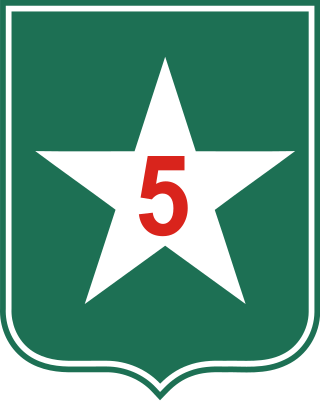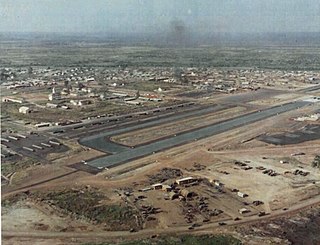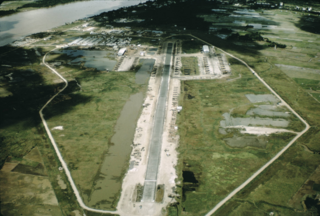
The 1st Cavalry Division is a combined arms division and is one of the most decorated combat divisions of the United States Army. It is based at Fort Cavazos, Texas. It was formed in 1921 and served during World War II, the Korean War, the Vietnam War, the Persian Gulf War, with the Stabilization Force in Bosnia-Herzegovina, in the Iraq War, in the War in Afghanistan as well as Operation Freedom's Sentinel and Operation Inherent Resolve. As of July 2023, the 1st Cavalry Division is subordinate to III Armored Corps and is commanded by Major General Kevin D. Admiral.

The Battle of Khe Sanh was conducted in the Khe Sanh area of northwestern Quảng Trị Province, Republic of Vietnam, during the Vietnam War. The main US forces defending Khe Sanh Combat Base (KSCB) were two regiments of the United States Marine Corps supported by elements from the United States Army and the United States Air Force (USAF), as well as a small number of Army of the Republic of Vietnam (ARVN) troops. These were pitted against two to three divisional-size elements of the North Vietnamese People's Army of Vietnam (PAVN).

The Battle of Đồng Xoài was a major battle fought during the Vietnam War as part of the Viet Cong (VC) Summer Offensive of 1965. It took place in Phước Long Province, South Vietnam, between June 9 and 13, 1965.

Khe Sanh Combat Base was a United States Marine Corps outpost south of the Vietnamese Demilitarized Zone (DMZ) used during the Vietnam War.

The 12th Combat Aviation Brigade is a Combat Aviation Brigade of the United States Army. It was first organized as the 12th Aviation Group at Fort Moore, Georgia, on 18 June 1965.

The Fifth Division of the Army of the Republic of Vietnam (ARVN)—the army of the nation state of South Vietnam that existed from 1955 to 1975—was part of the III Corps that oversaw the region of the country surrounding the capital, Saigon.

The 22nd Division of the Army of the Republic of Vietnam (ARVN) was part of the II Corps that oversaw the region of the Central Highlands north of the capital Saigon. The 22nd Division was based in Ba Gi near the south central coast.

Simmons Army Airfield is a military use airport located in Cumberland County, North Carolina, United States. It is located on the southeast portion of Fort Liberty and supports the aviation needs of the XVIII Airborne Corps, the 82nd Airborne Division, Special Operations, U.S. Army Reserve and U.S. National Guard aviation units.

The 3rd Battalion, 319th Field Artillery Regiment is the field artillery battalion that directly supports the 1st Brigade Combat Team, 82nd Airborne Division. Known as the "Gun Devils", 3–319th AFAR has participated in battles from World War I to the current day, and is one of the most highly decorated field artillery units in the United States Army. The battalion's mission is "3-319th AFAR stands ready to deploy worldwide within 18 hours of notification, execute a parachute assault and conduct full-spectrum operations. Specifically, the battalion will provide responsive lethal and nonlethal fires in support of forcible entry and airfield seizure, and integrate and synchronize the effects of fires to achieve the 1BCT commander's intent."

The 52nd Aviation Regiment is an aviation regiment of the U.S. Army.
The 304 Division is an infantry division of the People's Army of Vietnam (PAVN). It was established in January 1950 at Thanh Hoa.
The 2nd Battalion, 319th Field Artillery Regiment is the field artillery battalion that is assigned to the 2nd Brigade Combat Team, 82nd Airborne Division. Nicknamed "Black Falcons", 2–319 AFAR has participated in battles from World War I to the current day.

Phước Vĩnh Base Camp is a former U.S. Army base north of Biên Hòa in southern Vietnam.

Phu Loi Base Camp is a former U.S. Army base north of Saigon in southern Vietnam.

Vĩnh Long Airfield is a former United States Army base west of Vĩnh Long in Vĩnh Long Province, Mekong Delta, Vietnam.

The 214th Aviation Regiment is a parent aviation regiment of the United States Army, represented by the 1st Battalion, 214th Aviation, part of the 12th Combat Aviation Brigade, United States Army Europe (USAREUR) at Lucius D. Clay Kaserne, Wiesbaden.

Operation Badger Tooth was a search and destroy mission in the Street Without Joy area of Quảng Trị Province carried out by the 3rd Battalion, 1st Marines. Launched on 26 December 1967 the operation ended on 2 January 1968. The Marines reported the People's Army of Vietnam (PAVN) lost 131+ killed, while US casualties were 48 killed.

210th Aviation Regiment is aviation regiment of the United States Army.
145th Aviation Regiment is an aviation regiment of the United States Army. It was previously the 145th Combat Aviation Battalion which was operational during the Vietnam War under the control of the 12th Combat Aviation Group.

















